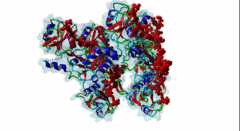| Accession: | |
|---|---|
| Functional site class: | Immunoreceptor tyrosine-based motif |
| Functional site description: | In the cytoplasmatic region of immunoreceptors there are motifs that are critical for the activation and termination of signal transduction pathways. |
| ELMs with same func. site: | LIG_TYR_ITAM LIG_TYR_ITIM LIG_TYR_ITSM |
| ELM Description: | ITAM (immunoreceptor tyrosine-based activatory motif). ITAM consists of partially conserved short sequence of amino acid found in the cytoplasmatic tail of antigen and Fc receptors. |
| Pattern: | [DEN]..(Y)..[LI].{6,12}(Y)..[LI] |
| Pattern Probability: | 0.0000024 |
| Present in taxon: | Vertebrata |
| Interaction Domain: |
SH2 (PF00017)
SH2 domain
(Stochiometry: 2 : 1)
|
Antigen recognition and communication among cells (T, B and natural killer cells) of the immune system are regulated at the level of cell-surface antigen and transmembrane receptors. The extracellular regions of these receptors provide the immune specificity, whereas the intracellular region interacts with cytoplasmatic signaling molecules that are critical for the activation and termination of signal transduction pathways. The initial signaling events following the engagement of antigen receptors are regulated by the phosphorylation of characteristic signaling motifs that coordinate the activity of protein tyrosine kinases (PTKs) and protein tyrosine phosphatases (PTPases), and thus regulate the activation or inhibition of the intracellular response. Some receptors like CD154, CD28, CD3 transmit mainly positive co-stimulatory signals, whereas others, such as CTLA-4 killer inhibitory receptors (KIRs) or leukocyte immunoglobulin-like receptors (LIRs), function principally as inhibitory receptors. In addition, a group of dual-function receptors, such as the CD150 subfamily within the CD2 family, can either act as positive or negative regulators. |
(click table headers for sorting; Notes column: =Number of Switches, =Number of Interactions)
| Acc., Gene-, Name | Start | End | Subsequence | Logic | #Ev. | Organism | Notes |
|---|---|---|---|---|---|---|---|
| P20963 CD247 CD3Z_HUMAN |
69 | 86 | QNQLYNELNLGRREEYDVLD | TP | 3 | Homo sapiens (Human) | |
| P07766 CD3E CD3E_HUMAN |
185 | 202 | PNPDYEPIRKGQRDLYSGLN | TP | 7 | Homo sapiens (Human) | |
| P30273 FCER1G FCERG_HUMAN |
62 | 79 | SDGVYTGLSTRNQETYETLK | TP | 5 | Homo sapiens (Human) | |
| P15530 Cd79b CD79B_MOUSE |
192 | 209 | EDHTYEGLNIDQTATYEDIV | TP | 6 | Mus musculus (House mouse) | |
| P40259 CD79B CD79B_HUMAN |
193 | 210 | EDHTYEGLDIDQTATYEDIV | TP | 4 | Homo sapiens (Human) | |
| P04234 CD3D CD3D_HUMAN |
146 | 163 | NDQVYQPLRDRDDAQYSHLG | TP | 2 | Homo sapiens (Human) | |
| P11912 CD79A CD79A_HUMAN |
185 | 202 | DENLYEGLNLDDCSMYEDIS | TP | 1 | Homo sapiens (Human) |
Please cite:
ELM-the Eukaryotic Linear Motif resource-2024 update.
(PMID:37962385)
ELM data can be downloaded & distributed for non-commercial use according to the ELM Software License Agreement
ELM data can be downloaded & distributed for non-commercial use according to the ELM Software License Agreement

